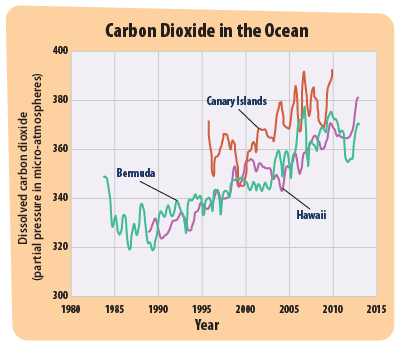Increased Ocean Acidity
 Carbon dioxide is added to the atmosphere whenever people burn fossil fuels. Oceans play an important role in keeping the Earth's carbon cycle in balance. As the amount of carbon dioxide in the atmosphere rises, the oceans absorb a lot of it. In the ocean, carbon dioxide reacts with seawater to form carbonic acid. This causes the acidity of seawater to increase.
Carbon dioxide is added to the atmosphere whenever people burn fossil fuels. Oceans play an important role in keeping the Earth's carbon cycle in balance. As the amount of carbon dioxide in the atmosphere rises, the oceans absorb a lot of it. In the ocean, carbon dioxide reacts with seawater to form carbonic acid. This causes the acidity of seawater to increase.
What's happening now?

The world's oceans are absorbing more carbon dioxide, as shown by the three sets of measurements in this graph. More carbon dioxide means increased acidity (lower pH). Source: EPA's Climate Change Indicators (2016).

Acidity, which is the amount of acid present in a solution, is measured using the pH scale. The lower the pH, the more acidic the substance. Source: Adapted from Environment Canada (2010).
Over the last few decades, the amount of carbon dioxide dissolved in the ocean has increased all over the world, and so has ocean acidity.
What will happen in the future?
As long as we keep putting extra carbon dioxide in the atmosphere, the acidity of the ocean will continue to increase.
Why does it matter?
Increasing acidity will make it harder for corals to build skeletons and for shellfish to build the shells they need for protection. Corals are particularly important because they provide homes for many other sea creatures.
Check out the effects of ocean acidity on plants, animals, and ecosystems.